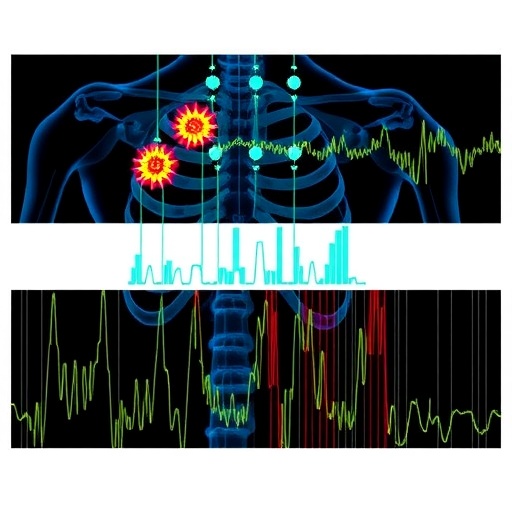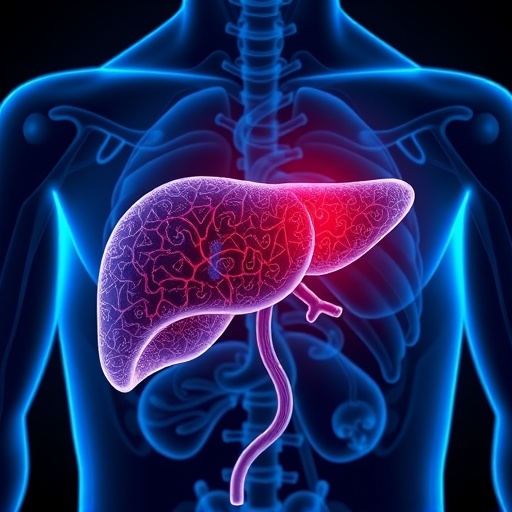In the ever-evolving landscape of cancer research and management, scientists are persistently seeking innovative approaches to revolutionize diagnosis and treatment. A groundbreaking development now emerges from the convergence of nanotechnology, wearable devices, and molecular biology: wearable nanopatch platforms capable of real-time microRNA (miRNA) sensing and editing. This visionary advance promises to pave the way for next-generation cancer management, delivering unprecedented precision and responsiveness in detecting and modulating cancer-associated biomarkers.
MicroRNAs have been firmly established as pivotal regulators of gene expression, profoundly influencing cancer progression, metastasis, and patient prognosis. These short, non-coding RNA molecules act by fine-tuning the translation of multiple oncogenes and tumor suppressor genes, making their detection and manipulation crucial for personalized cancer therapies. Conventional miRNA detection techniques, however, remain largely confined to invasive biopsies and laboratory-bound assays, limiting timely intervention possibilities.
The newly designed wearable nanopatch harnesses cutting-edge nanomaterials engineered for biocompatibility and sensitivity. When applied to the skin, this flexible patch interfaces directly with bodily fluids, continuously monitoring miRNA fluctuations in real-time. Such a platform integrates nanoelectronic sensors with molecular recognition elements that selectively bind target miRNAs, transducing biochemical interactions into electrical signals with exceptional accuracy. This dynamic monitoring capability enables early detection of oncogenic activity, well before symptomatic manifestations.
Beyond mere sensing, the true innovation lies in the nanopatch’s ability to perform on-demand miRNA editing. Utilizing CRISPR-based gene-editing enzymes encapsulated within nanocarriers embedded in the patch, the device can modulate miRNA expression profiles directly at the skin interface. This function not only facilitates immediate therapeutic intervention but also allows for personalized adjustments tailored to the molecular fingerprint of the individual’s cancer, profoundly enhancing clinical outcomes.
The implications for cancer management are profound. Real-time surveillance eliminates the latency that typically hampers conventional diagnostic workflows, empowering clinicians to make agile treatment decisions. Furthermore, the non-invasive nature of the NP platform significantly reduces patient discomfort and barriers to frequent monitoring. Patients can thus maintain continuous oversight over their disease state without disrupting daily life or requiring hospital visits.
Technologically, the innovation integrates multiple disciplines—nanofabrication, bioelectronics, synthetic biology, and molecular medicine—into a seamless wearable form factor. The nanopatch features a multilayer architecture incorporating nano-scale electrodes, hydrogel matrices for sustained enzymatic activity, and wireless communication modules to transmit data securely to healthcare providers. This end-to-end design ensures that raw molecular data are promptly converted into actionable insights, facilitating telemedicine and remote cancer care delivery.
The precision of miRNA detection is optimized by the patch’s high affinity and specificity sensors, achieved through the functionalization of the nanomaterial surfaces with nucleotide probes complementary to target miRNAs. These probes capture circulating or extracellular vesicle-encapsulated miRNAs shed from tumor cells, amplifying detection sensitivity. Such sensitivity is vital for tracking subtle molecular shifts indicative of early tumorigenesis or therapeutic resistance.
Furthermore, the CRISPR-based editing mechanism embedded in the nanopatch leverages newer, highly efficient Cas proteins engineered to minimize off-target effects. Their delivery via nano-carriers ensures stability and controlled release within the local environment, limiting systemic exposure and potential adverse reactions. This localized editing corroborates the emerging paradigm of precision oncology, where interventions are meticulously tailored to an individual’s molecular profile.
A critical aspect of this technology lies in its adaptability. The nanopatch is designed to be reprogrammable, allowing updates to its sensing and editing capabilities to accommodate emerging miRNA biomarkers linked to diverse cancer subtypes. This flexibility ensures longevity and relevance in a field characterized by rapid biomarker discovery and evolving molecular therapeutics.
Clinicians and patients alike stand to benefit from this seamless integration of diagnostics and therapeutics. By enabling continuous, real-time monitoring and responsive molecular intervention, this platform could significantly reduce cancer mortality through early detection and timely treatment modulation. It also promises to optimize resource allocation within healthcare systems by diminishing invasive procedures and hospital visits.
While clinical translation will require rigorous validation, including long-term biocompatibility, regulatory approvals, and integration into existing treatment protocols, the potential impact of these wearable nanopatch platforms marks a paradigm shift. They not only bridge the gap between diagnostics and therapeutics but also democratize molecular-level cancer management, facilitating early, personalized, and less burdensome care.
Moreover, the vast data generated through continuous monitoring offer fertile ground for machine learning applications. Predictive analytics could discern patterns and prognostic indicators from miRNA dynamics, further enhancing disease management strategies and enabling predictive rather than reactive medicine.
As cancer continues to afflict millions globally, innovations such as these wearable nanopatch systems underscore the profound benefits of interdisciplinary research converging on molecular medicine. By embedding real-time sensing and editing at the skin level, science is steering towards a future where cancer detection and intervention become faster, smarter, and more patient-centric than ever before.
This visionary platform embodies the future of oncology: wearable, intelligent, and molecularly precise devices transforming the way we confront cancer—turning the battle into a manageable, monitored, and editable molecular dialogue. Its emergence heralds a new chapter in personalized medicine, promising to save lives through technology that is literally at one’s fingertips.
Subject of Research: Wearable nanopatch platforms for real-time miRNA sensing and editing in cancer management.
Article Title: Wearable nanopatch platforms for real-time miRNA sensing and editing: a vision for next-generation cancer management.
Article References:
Ameya, K.P., Ross, K. & Sekar, D. Wearable nanopatch platforms for real-time miRNA sensing and editing: a vision for next-generation cancer management. Med Oncol 42, 554 (2025). https://doi.org/10.1007/s12032-025-03091-8
Image Credits: AI Generated
DOI: https://doi.org/10.1007/s12032-025-03091-8
Tags: biocompatible nanomaterials for healthcontinuous monitoring of cancer biomarkersearly detection of oncogenic activityflexible wearable devices for health monitoringmicroRNA role in cancer progressionmolecular biology advancements in oncologynanoelectronic sensors in medicinenanotechnology in cancer researchnon-invasive cancer diagnostic methodspersonalized cancer therapy innovationsreal-time microRNA sensing technologywearable nanopatches for cancer monitoring






